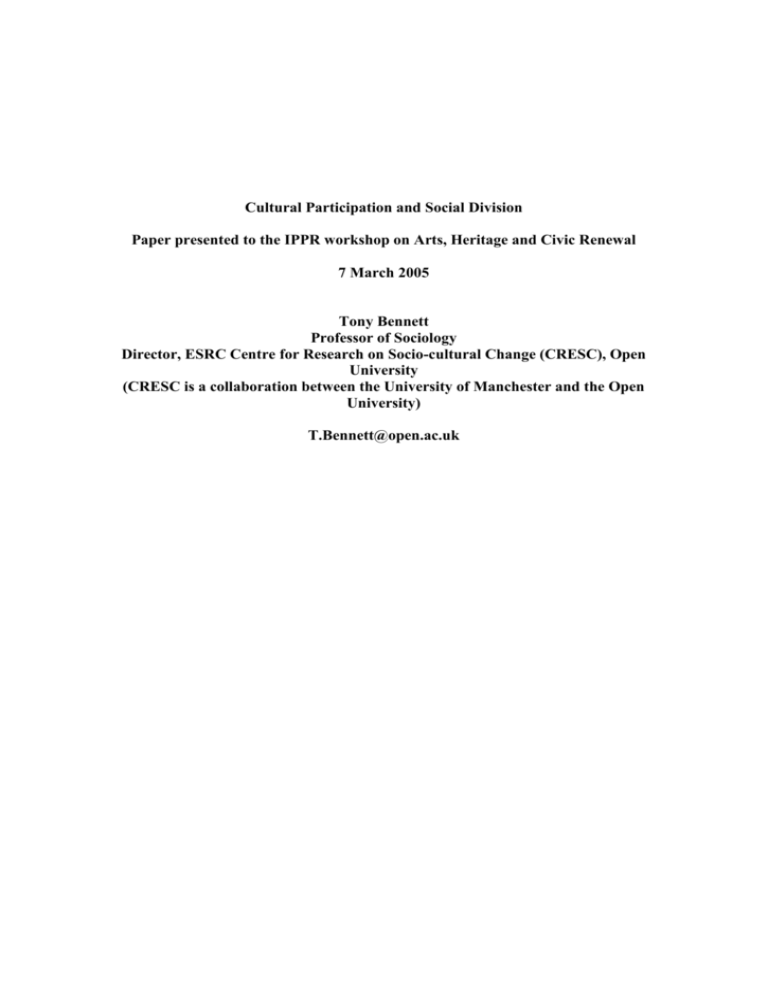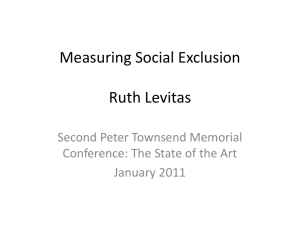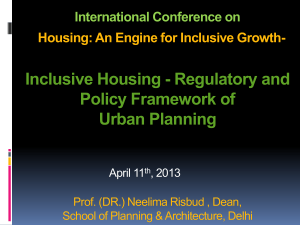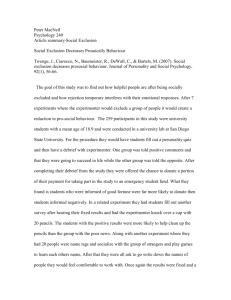Cultural Participation and Social Division
advertisement

Cultural Participation and Social Division Paper presented to the IPPR workshop on Arts, Heritage and Civic Renewal 7 March 2005 Tony Bennett Professor of Sociology Director, ESRC Centre for Research on Socio-cultural Change (CRESC), Open University (CRESC is a collaboration between the University of Manchester and the Open University) T.Bennett@open.ac.uk 2 I should like, first, to express my appreciation of Geoff Mulgan’s presentation for offering a very useful overview of the range of ways in which cultural policies are currently connected to concerns about civic renewal. I also welcomed the notes of caution that are sounded regarding the effectiveness of such policies, and the scepticism that is registered regarding whether culture can reasonably be expected to deliver what is being asked of it in being called on to promote social cohesion, engender civic renewal, revitalise depressed economic regions, foster community solidarity and promote cross-cultural understanding – to name but a few of the tasks for which it is currently enlisted. Since I share these views, shall try to complement them – but from a different perspective – by addressing three issues. I want to ask, first, why culture is currently being asked to do so much by placing the demands that are made of it in the setting of broader policy settings and processes. Second, I shall focus on some of the contradictory directions presented by these demands for, at the same time that so much effort is being invested in the use of culture as a means of building up social capital and social cohesion, its role as a divisive force in society when considered at an aggregate level remains largely undiminished. I shall then, as my third point, argue that this will remain so unless those aspects of cultural policies that are concerned to increase access to and use of cultural resources as a matter of social-democratic civic entitlement are given more support – in themselves and in the education policies that they need as allies. In addressing the second and third of the issues, I shall draw on the work of the French sociologist Pierre Bourdieu and his account of the role of cultural divisions in organising social divisions and introduce some of the preliminary findings from a project modelled on Bourdieu’s work examining the relations between cultural capital and social exclusion in contemporary Britain. However, to come back to my first point: why is so much being asked of culture? One of the best answers to this question that I know of comes from George Yúdice (2003) who, in his book The Expediency of Culture: Uses of Culture in the Global Era, argues that, over the last twenty to thirty years, the role of culture has expanded into the political and economic realms in unprecedented ways and to an unprecedented degree while, at the same, conventional aesthetic notions of culture – as an end in itself – have been largely emptied out. And he argues that this is because, and is evident in, the respects in which culture is now overwhelmingly regarded as a resource – as a set of instruments to be used for one or more of a range of social and economic purposes. Culture is thus now widely viewed internationally as something to be invested in, by governments or other agents, because it promises to regenerate depressed economies, promote cross-cultural understanding, foster productive identities, heal blighted communities, reform offenders, promote urban renewal, etc. And it is because, in this new logic of culture, Yúdice argues, everything is treated equally as a resource that the distinction between art or high culture and other forms of culture has been flattened out – since the logic that governs decisions about whether to invest in them is ostensibly of the same kind, orientated to a calculation of their instrumental value in some economic or social purpose. To account for the extended range of social purposes culture is now called on to perform, Yúdice traces the parallels between these and the growth of neo-liberal policies. He focuses on two aspects of these: first, the failure of the promised trickledown effect of neo-liberal economic policies to materialise as, instead, the 1990s and 3 early 2000s have witnessed increasing inequalities in both the US and Britain; and, second, the reduced subventions of social services as neo-liberal social policies have led to a withdrawal of the state in the interest of producing more entrepreneurial and self-reliant citizens. These, plus the consequences of globalisation in pluralizing the ‘ethnic’ or cultural composition of national populations, Yúdice argues, have combined to suggest the need for compensatory investment in civil society and its institutions – with culture emerging as the prime animator and favoured candidate for such investment. While none of this takes away from the specific issues that are posed by particular social and civic uses of cultural resources – issues concerning, for example, how best to refashion museums so as to promote cross-cultural understanding, the use of art to resocialise offenders, or the development of community arts projects as a means building up social capital – it does suggest that, when framed in the context of larger tendencies, their role is perhaps best seen as that of low-cost ways of seeking to offset the side-effects of neo-liberal policies. This means, of course, that the task of deploying culture as a means of ameliorating a conflicted and damaged civil society is likely to prove a Sisyphean one so long as neo-liberal policies widen social divisions by increasing social inequalities. But the central paradox in this is that, so far as the big money is concerned, the state’s investment in culture is itself allied much more to the operation of culture as a means of producing and organising social divisions than to overcoming or ameliorating them. Let me, to substantiate these arguments, briefly outline some of the findings coming out of a project on Cultural Capital and Social Exclusion that I, together with coresearchers from the Open University and the University of Manchester, are currently working on.i This inquiry, funded by the Economic and Social Research Council,ii includes a major survey component, a questionnaire exploring people’s cultural activities, tastes and preferences and relating these to their class positions, levels of education, ethnicity, gender, occupations, etc. This was administered to a national random sample of 1564 respondents and an ethnic boost sample of Indian, Pakistani and Afro-Caribbean respondents between November 2003 and March 2004.iii In one section of the questionnaire, we asked how often our respondents went to a range of cultural venues: the cinema, museums, pubs, rock concerts, opera, bingo, orchestral/choral concerts, the theatre, art galleries, night clubs, and eating out. Those with professional occupations, managers and employers had rates of participation in all of these above the mean for the sample as a whole – except for pubs, bingo, and night clubs where their rates of participation were below the mean.iv For museums, opera, concerts, and art galleries, only professionals recorded levels of participation above the mean. These patterns were pretty much reversed for respondents in the four lowest occupational classes – skilled, semi-skilled, and lower supervisory workers, and the self-employed. These participated above the mean only in relation to cinema, bingo and night clubs, participating less than the mean in all the other activities. Looking at the same cultural activities in relation to levels of education shows that having, or not having, a degree is the main dividing line. Only those with degrees participated above the mean in visiting museums, attending orchestral/choral concerts, visiting stately homes/heritage sites, or going to the theatre, and the same tendency was discernible in the case of art galleries except that the key dividing line here was between those with, and those without, A levels. What we see, then, is that well- 4 educated middle-class professionals and managers are the most likely to be heavily involved in those parts of the cultural sector that are dependent on public funding whereas less well educated unskilled and semi-skilled workers are more exclusively involved in the commercial cultural sector. Level of education plays a similarly discriminating role in relation to the scope of cultural knowledge of our respondents.v We explored this by asking them whether they had heard of or seen: four national events broadcast on television (the Grand National, the World Cup, the Queen’s Christmas broadcast, and the General Election results night), the work of six film directors (Stephen Spielberg, Alfred Hitchcock, Pedro Almodovar, Ingmar Bergman, Jane Campion, and Mani Rathnam), eight pieces of music (Wonderwall by Oasis, Stan by Eminem, Four Seasons by Vivaldi, Einstein on the Beach by Philip Glass, Symphony no 5 by Mahler, Kind of Blue by Miles Davis, Oops I Did it Again by Britney Spears, and Chicago by Frank Sinatra), and the named works of six authors (Jane Austen’s Pride and Prejudice, J.K. Rowling’s Harry Potter and the Chamber of Secrets, Catherine Cookson’s Solace of Sin, John Grisham’s The Firm, Gustave Flaubert’s Madame Bovary, and Maya Angelou’s I Know Why the Caged Bird Sings). Bringing together the results for all answers to these questions yielded a rough-and-ready ‘scale of knowledge’. Those who had responses in the top quartile of this scale (this was for those whose answers showed that they had some knowledge of 18 or more of the 24 named items) were recruited in their highest ratios from, first, those with postgraduate degrees, and then those with undergraduate degrees and A-levels, and in their lowest ratios from those with no educational qualifications. These are just a couple of snapshots from a much larger body of data. They are, however, consistent with the general tendency emerging from this data in suggesting strong correlations between level of education and class position and the particular kinds of cultural taste, levels of cultural knowledge and patterns of cultural participation. Before commenting on the policy conclusions which might follow from this, I want to say a few words about the concept of social exclusion, particularly about how its meaning has been transformed in the context of neo-liberal policies, and the dimensions I think need to be restored to it. In doing so I shall draw on Ruth Levitas’s discussion of the concept. Levitas (1998, 2004) shows how, when first introduced into British debates from the French 1970s policy debates where it originated, the concept of social exclusion had a strong redistributive aspect – the socially excluded were not regarded as a special group or underclass set apart from the rest of society, but as the poor where poverty was regarded as merely one manifestation of broader patterns of inequality, and one that could be resolved only through redistributive means through both incomes policies and public services aimed at distributing income and wealth (private and public) more equally throughout society as a whole. Since then, and particularly in the context of the neo-liberal policies and the third way, Levitas argues that this initial sense of social exclusion – which resonated with the social-democratic co-ordinates of 1970s policies – has mutated into something else as it has come to refer more to a separate group of the excluded as a combination of (i) those who are out of work or in other contexts (eg sink estates) which hinder 5 their integration into the ‘mainstream’, and (ii) a moral underclass whose exclusion is partly a matter of failed moral propensities (the work shy, criminal young men). The significant aspect of these redefinitions, Levitas argues, is that they shift the problem of social exclusion away from general redistributive issues in the context of income and wealth divisions that affect those in work, and the mainstream, and not just an excluded underclass, and make the resolution of social exclusion dependent on various kinds of moral action (which is where culture comes in) on separated, specially defined groups. It is too early in our work to say yet with confidence what kind of conception of the socially excluded our data will lend support to, or even whether this is the best category to use in relation to those who take part in relatively few cultural activities. It is clear, however, that the theories we are exploring – those suggested by Pierre Bourdieu’s account of cultural capital – point a different direction in suggesting that these have to be seen as parts of more general patterns of division between participation in cultural activities ranked most high (art, literature, music, etc) and validated by the education system, leading, in turn, to educational advancement and occupational preferment on the part of those familiar with them, as playing a key role in the processes through which the professional middle classes acquire, define and pass on their inheritance. The policy directions in which considerations of this kind point means weakening or severing these exclusive connections so that the ability to access and choose knowledgeably from the full range of culture becomes more equally available to all citizens – and that means focusing on the relations between education policies and cultural policies. It’s a matter, if you like, of recognising that saying ‘Culture, Culture, Culture’ is also a matter of saying ‘Education, Education, Education’ – which means support for education policies that do not deliver an already stratified adult citizenry to the doors of museums, galleries, theatres, cinemas, etc., and then expects these to be able to undo those divisions through the palliative forms of action that they have at their disposal. This is why a unified system of certification of the kind urged in the Tomlinson Report on the reform of secondary qualifications have such important implications for cultural policies – though, sadly, this looks like another missed opportunity given the government’s decision to jettison this aspect of Tomlinson’s recommendations. I want, in closing, to introduce another element into the picture. Pierre Bourdieu’s work has focused mainly on the relations between class, education and culture. Ghassan Hage (1998), an Australian scholar who studied with Bourdieu, has developed a framework for examining similar processes at work in the relations between dominant and minority ethnic groups. Suggesting that familiarity with the national culture provides not just a sense of national belongingness but also a resource than can be used to advantage, Hage argues that the lack of such familiarity on the part of migrants can serve as a barrier to their social advancement. It is worth noting that the Indian, Pakistani and Afro-Caribbean respondents in our ethnic boost sample were much less familiar with representative examples of British and, more generally, Western art, literature and music than were respondents in the main sample: painters like Picasso, Van Gogh, Turner and Lowry, for example, or writers like Jane Austen and Catherine Cookson, for example. It is difficult, this stage, to know how best to interpret these figures. Do they suggest social exclusion from the mainstream on the part of minority ethnic groups as a form of threat to social cohesion? Or social exclusion as a form of disadvantage in relation to the acquisition of distinctively 6 national forms of cultural capital? The questions are important ones for, depending on how they are answered, different kinds of policy responses will be appropriate. Endnotes i The other members of the research team are Mike Savage (University of Manchester), Elizabeth Silva (Open University), and Alan Warde (university of Manchester) as the co-applicants, and, as the project research fellows, Modesto Gay-Cal (University of Manchester) and David Wright (Open University). ii ESRC award no. R000239801 iii The survey was conducted by the National Centre for Social Research. For the technical report, see Thomson (2004). iv I draw here on analysis of the data undertaken by Modesto Gayo-Cal. v I draw here on analysis of the data undertaken by Alan Warde and Modesto Gayo-Cal. References Hage, Ghassan (1998) White Nation: Fantasies of White Supremacy in a Multlicultural Society, Sydney: Pluto Press. Levitas, Ruth (1998) The Inclusive Society? Social Exclusion and New Labour, Basingstoke: Macmillan. Levitas, Ruth (2004) ‘Let’s hear it for Humpty: social exclusion, the third way, and cultural capital’, Cultural Trends, 13 (2), pp. 41-56. Thomson, Katarina (2004) Cultural Capital and Social Exclusion: Technical Report, London: National Centre for Social Research. Yúdice, George (2003) The Expediency of Culture: Uses of Culture in the Global Era, Durham and London: Duke University Press. 7








